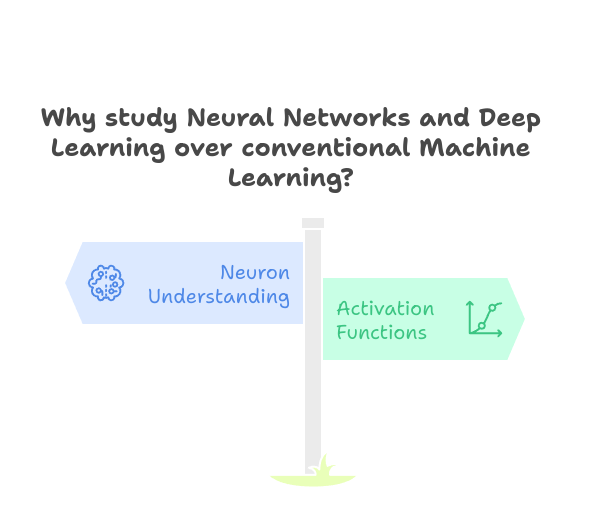Neural Networks - Activation Function, Weights and Bias
 Ashok Vanga
Ashok Vanga
Traditional Machine Learning algorithms like Decision Trees, Support Vector Machines (SVM), and Logistic Regression have been widely used for years.
However, these methods have limitations when dealing with:
✔ Complex Data (Images, Text, Audio, Video)
✔ Unstructured Data (Raw text, sensor data, IoT streams)
✔ Feature Engineering Challenges (Manually selecting important features)
With the rise of Big Data and increasing computational power (GPUs, TPUs), more advanced models are required.
When the goal is to develop highly accurate, scalable models that can:
🔹 Automatically learn complex patterns from raw data.
🔹 Handle massive datasets efficiently.
🔹 Adapt to new challenges without heavy manual intervention.
To achieve this, we need to explore Neural Networks and Deep Learning.
How Neural Networks & Deep Learning Solve These Issues)
✅ 1. Handles High-Dimensional Data Better
Conventional ML struggles with large image datasets (e.g., medical scans, facial recognition).
Deep Learning (CNNs) can extract patterns from pixels without manual feature engineering.
Example: Self-driving cars use Convolutional Neural Networks (CNNs) to detect objects in real-time.
✅ 2. Learns Representations Automatically
Traditional ML requires manual feature selection (e.g., selecting the best features in tabular data).
Deep Learning automatically extracts features at multiple levels.
Example: In NLP, Word2Vec and Transformer models (BERT, GPT) learn word relationships without requiring manual encoding.
✅ 3. Better Performance with More Data
Many ML algorithms saturate in performance after a certain amount of data.
Neural Networks improve as more data is added (given enough computational power).
Example: Google Translate improved drastically when more text data was fed into deep learning models.
✅ 4. Works Well on Unstructured Data
Most real-world data is unstructured (images, text, audio, video).
Deep Learning models like CNNs, RNNs, and Transformers can handle this seamlessly.
Example: Chatbots like ChatGPT use deep learning models to generate human-like responses.
✅ 5. Scalability with GPUs and TPUs
ML models become slow with large datasets.
Deep Learning leverages parallel computing with GPUs/TPUs to train faster.
Example: AlphaGo by DeepMind defeated human champions in Go using deep reinforcement learning.
Impact of Deep Learning vs. Traditional ML
✅ Higher accuracy in vision, NLP, speech recognition, and time-series forecasting.
✅ Less manual feature engineering → reduces human effort in data preprocessing.
✅ Scalable to big data → performs better with larger datasets.
✅ Enables AI breakthroughs like ChatGPT, DALL·E, Tesla Autopilot, and DeepFake detection.
In traditional Machine Learning, we use models like Linear Regression and Decision Trees to make predictions.
However, these models struggle with complex relationships in data, like images, speech, and language understanding.
To solve this, Neural Networks were inspired by the human brain, where the fundamental unit is a neuron.
To build a model that mimics how the human brain learns, we need:
✔ A Neuron that processes inputs and produces an output.
✔ An Activation Function that helps the neuron decide what to “fire” (activate) or ignore.
What is a Neuron in a Neural Network?
A neuron is the basic building block of a neural network. It:
🔹 Takes input features (e.g., Age, Salary, Pixels in an image).
🔹 Applies weights and bias to adjust importance.
🔹 Passes the result through an activation function to produce an output.

✅ Example of a Neuron
Imagine a spam filter that classifies emails as Spam (1) or Not Spam (0).
Inputs: Email content, sender, number of links
Weights adjust how important each feature is.
Activation Function decides if the email is spam or not.
What is an Activation Function and Why is it Needed? Why are Activation Functions Used?
An activation function helps the neuron decide whether to activate (fire) or not.
Neural networks are powerful, but they need a mechanism to decide which neurons should be activated and how to introduce non-linearity into the model.
If we use only linear transformations, the network would behave like a simple linear regression model and fail to learn complex patterns.
To enable neural networks to learn complex relationships, we need:
✔ Activation Functions to determine neuron activation.
✔ Non-linearity to capture complex patterns in data.
Without an activation function, a neural network cannot perform well on real-world tasks like image recognition, speech processing, or language translation.
Why Are Activation Functions Used?
✔ Introduce Non-Linearity → Allows the network to learn complex decision boundaries.
✔ Enable Deep Learning → Without them, a neural network would just be a linear model!
✔ Improve Convergence → Helps models train efficiently and avoid issues like saturation.
✔ Help Control Gradients → Prevents exploding or vanishing gradients in deep networks.
Types of Activation Functions:

Impact of Neurons & Activation Functions
✅ Neurons allow deep learning models to learn patterns like humans.
✅ Activation Functions introduce non-linearity, allowing networks to solve complex problems like speech, vision, and NLP.
✅ Deep Learning wouldn’t work without activation functions!
Choosing the best activation function for your model?

Subscribe to my newsletter
Read articles from Ashok Vanga directly inside your inbox. Subscribe to the newsletter, and don't miss out.
Written by
Ashok Vanga
Ashok Vanga
Golang Developer and Blockchain certified professional